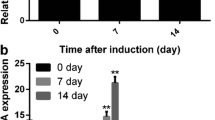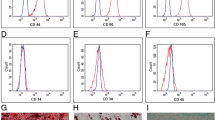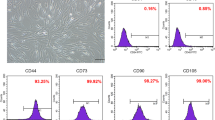Abstract
In this study we have inhibited the expression of two negative regulators of chondrogenesis, Slug transcription factor (TF) and the small non-coding single stranded RNA microRNA-221 (miR-221), in human mesenchymal stem cells (MSCs). Our aim was test a new approach to guide the cells toward a chondrocyte – like phenotype, without the employment of differentiating agents, in the prospect of their clinical applications for cell-based cartilage tissue engineering. We have characterized these manipulated cells by gene expression analysis at the RNA and protein levels. We demonstrated that decreased miR-221 or Slug induced an increase of chondrogenic markers, including collagen type II (Col2A1), and the positive chondrogenic TFs Sox9 and TRPS1. Slug and TRPS1 are not direct targets of miR-221 since their expression was not affected by miR-221 content. Further, we showed by gene expression and Chromatin Immunoprecipitation analyses that i. miR-221 is positively regulated by Slug in hMSCs, where Slug and miR-221 high levels hamper cell differentiation, and ii. TRPS1 contributes to maintaining low levels of miR-221, both in hMSCs committed toward chondrogenesis by Slug depletion and in chondrocytes, where the low levels of miR-221 and Slug allow a chondrogenic phenotype.
Taken together, our data may be relevant both to understand yet unknown miRNA – TF regulatory loops in cartilage biology and to establish new strategies based on a siRNA approach for cartilage tissue engineering.








Similar content being viewed by others
References
Caplan, A. I. (2007). Adult mesenchymal stem cells for tissue engineering versus regenerative medicine. Journal of Cellular Physiology, 213, 341–347.
Arthur, A., Zannettino, A., & Gronthos, S. (2009). The therapeutic applications of multipotential mesenchymal/stromal stem cells in skeletal tissue repair. Journal of Cellular Physiology, 218, 237–245.
Vinatier, C., Mrugala, D., Jorgensen, C., Guicheux, J., & Noël, D. (2009). Cartilage engineering: a crucial combination of cells, biomaterials and biofactors. Trends in Biotechnology, 27, 307–314.
Barzilay, R., Melamed, E., & Offen, D. (2009). Introducing transcription factors to multipotent mesenchymal stem cells: making transdifferentiation possible. Stem Cells, 27, 2509–2515.
Palmer, G. D., Steinert, A., Pascher, A., Gouze, E., Gouze, J. N., Betz, O., et al. (2005). Gene-induced chondrogenesis of primary mesenchymal stem cells in vitro. Molecular Therapy, 12, 219–228.
Oldershaw, R. A. (2012). Cell sources for the regeneration of articular cartilage: the past, the horizon and the future. International Journal of Experimental Pathology, 93, 389–400.
de Crombrugghe, B., Lefebvre, V., & Nakashima, K. (2001). Regulatory mechanisms in the pathways of cartilage and bone formation. Current Opinion in Cell Biology, 13, 721–727.
Steinert, A. F., Ghivizzani, S. C., Rethwilm, A., Tuan, R. S., Evans, C. H., et al. (2007). Major biological obstacles for persistent cell-based regeneration of articular cartilage. Arthritis Research & Therapy, 9, 213.
Roobrouck, V. D., Vanuytsel, K., & Verfaillie, C. M. (2011). Concise review: culture mediated changes in fate and/or potency of stem cells. Stem Cells, 29, 583–589.
Caplen, N. J. (2004). Gene Therapy Progress and Prospects. Downregulating gene expression: the impact of RNA interference. Gene Therapy, 11, 1241–1248.
Cheema, S. K., Chen, E., Shea, L. D., & Mathur, A. B. (2007). Regulation and guidance of cell behavior for tissue regeneration via the siRNA mechanism. Wound Repair and Regeneration, 15, 286–295.
Cobaleda, C., Pérez-Caro, M., Vicente-Dueñas, C., & Sánchez-García, I. (2007). Function of the zinc-finger transcription factor SNAI2 in cancer and development. Annual Reviewes Genetics, 41, 41–61.
Garofalo, M., Quintavalle, C., Romano, G., Croce, C. M., & Condorelli, G. (2012). miR221/222 in cancer: their role in tumor progression and response to therapy. Current Molecular Medicine, 12, 27–33.
Seki, K., Fujimori, T., Savagner, P., Hata, A., Aikawa, T., Ogata, N., et al. (2003). Mouse Snail family transcription repressors regulate chondrocyte, extracellular matrix, type II collagen, and aggrecan. Journal of Biological Chemistry, 278, 41862–41870.
Goldring, M. B., Tsuchimochi, K., & Ijiri, K. (2006). The control of chondrogenesis. Journal of Cellular Biochemistry, 97, 33–44.
Kim, D., Song, J., & Jin, E. J. (2010). MicroRNA-221 regulates chondrogenic differentiation through promoting proteosomal degradation of slug by targeting Mdm2. Journal of Biological Chemistry, 285, 26900–26907.
Bakhshandeh, B., Soleimani, M., Paylakhi, S. H., & Ghaemi, N. (2012). A microRNA signature associated with chondrogenic lineage commitment. Journal of Genetics, 91, 171–182.
Karlsen, T. A., Shahdadfar, A., & Brinchmann, J. E. (2011). Human primary articular chondrocytes, chondroblasts-like cells, and dedifferentiated chondrocytes: differences in gene, microRNA, and protein expression and phenotype. Tissue Engineering. Part C, Methods, 17, 219–227.
Hemavathy, K., Guru, S. C., Harris, J., Chen, J. D., & Ip, Y. T. (2000). Human slug is a repressor that localizes to sites of active transcription. Molecular and Cellular Biology, 20, 5087–5095.
Gordeladze, J. O., Djouad, F., Brondello, J. M., Noël, D., Duroux-Richard, I., Apparailly, F., et al. (2009). Concerted stimuli regulating osteo-chondral differentiation from stem cells: phenotype acquisition regulated by microRNAs. Acta Pharmacologica Sinica, 30, 1369–1384.
Yang, B., Guo, H., Zhang, Y., Chen, L., Ying, D., & Dong, S. (2011). MicroRNA-145 regulates chondrogenic differentiation of mesenchymal stem cells by targeting Sox9. PloS One, 6, e21679.
Hong, E., & Reddi, A. H. (2012). MicroRNAs in chondrogenesis, articular cartilage, and osteoarthritis: implications for tissue engineering. Tissue Engineering Part B, 18, 445–453.
Penolazzi, L., Tavanti, E., Vecchiatini, R., Lambertini, E., Vesce, F., Gambari, R., et al. (2010). Encapsulation of mesenchymal stem cells from Wharton’s jelly in alginate microbeads. Tissue Engineering. Part C, Methods, 16, 141–155.
Wachsmuth, L., Soder, S., Fan, Z., Finger, F., & Aigner, T. (2006). Immunolocalization of matrix proteins in different human cartilage subtypes. Histology and Histopathology, 21, 477–485.
Candrian, C., Vonwil, D., Barbero, A., Bonacina, E., Miot, S., Farhadi, J., et al. (2008). Engineered cartilage generated by nasal chondrocytes is responsive to physical forces resembling joint loading. Arthritis and Rheumatism, 58, 197–208.
Pleumeekers, M. M., Nimeskern, L., Koevoet, W. L., Kops, N., Poublon, R. M., Stok, K. S., et al. (2014). The in vitro and in vivo capacity of culture-expanded human cells from several sources encapsulated in alginate to form cartilage. European Cells and Materials, 27, 264–280.
Do Amaral, R. J. F. C., Da Pedrosa, C. S. G., Kochem, M. C. L., Da Silva, K. R., Aniceto, M., Claudio-da-Silva, C., et al. (2012). Isolation of human nasoseptal chondrogenic cells: a promise for cartilage engineering. Stem Cell Research, 8, 292–299.
Lambertini, E., Lisignoli, G., Torreggiani, E., Manferdini, C., Gabusi, E., Franceschetti, T., et al. (2009). Slug gene expression supports human osteoblast maturation. Cellular and Molecular Life Sciences, 66, 3641–3653.
Lambertini, E., Lolli, A., Vezzali, F., Penolazzi, L., Gambari, R., & Piva, R. (2012). Correlation between slug transcription factor and miR-221 in MDA-MB-231 breast cancer cells. BMC Cancer, 12, 445.
Medici, D., Hay, E. D., & Olsen, B. R. (2008). Snail and Slug promote epithelial-mesenchymal transition through beta-catenin-T-cell factor-4-dependent expression of transforming growth factor-beta3. Molecular Biology of the Cell, 19, 4875–4887.
Brandl, M., Seidler, B., Haller, F., Adamski, J., Schmid, R. M., Saur, D., et al. (2010). IKK(α) controls canonical TGF(ß)-SMAD signaling to regulate genes expressing SNAIL and SLUG during EMT in panc1 cells. Journal of Cell Science, 123, 4231–4239.
Malik, T. H., Shoichet, S. A., Latham, P., Kroll, T. G., Peters, L. L., & Shivdasani, R. A. (2001). Transcriptional repression and developmental functions of the atypical vertebrate GATA protein TRPS1. EMBO Journal, 20, 1715–1725.
Umlauf, D., Frank, S., Pap, T., & Bertrand, J. (2010). Cartilage biology, pathology, and repair. Cellular and Molecular Life Sciences, 67, 4197–4211.
Lefebvre, V., & Smits, P. (2005). Transcriptional control of chondrocyte fate and differentiation. Birth Defects Research Part C, 75, 200–212.
Sun, W., Julie Li, Y. S., Huang, H. D., Shyy, J. Y., & Chien, S. (2010). microRNA: a master regulator of cellular processes for bioengineering systems. Annual Reviews Biomedical Engineering, 12, 1–27.
Anokye-Danso, F., Snitow, M., & Morrisey, E. E. (2012). How microRNAs facilitate reprogramming to pluripotency. Journal of Cell Science, 125, 4179–4187.
Torreggiani, E., Lisignoli, G., Manferdini, C., Lambertini, E., Penolazzi, L., Vecchiatini, R., et al. (2012). Role of Slug transcription factor in human mesenchymal stem cells. Journal of Cellular and Molecular Medicine, 16, 740–751.
Handorf, A. M., & Li, W. J. (2011). Fibroblast growth factor-2 primes human mesenchymal stem cells for enhanced chondrogenesis. PloS One, 6, e22887.
Temenoff, J. S., & Mikos, A. G. (2000). Review: tissue engineering for regeneration of articular cartilage. Biomaterials, 21, 431–440.
Gadjanski, I., Spiller, K., & Vunjak-Novakovic, G. (2012). Time-dependent processes in stem cell-based tissue engineering of articular cartilage. Stem Cell Reviews and Reports, 8, 863–881.
Johnstone, B., Alini, M., Cucchiarini, M., Dodge, G. R., Eglin, D., Guilak, F., et al. (2013). Tissue engineering for articular cartilage repair - the state of the art. European Cells & Materials, 25, 248–267.
van Beuningen, H. M., Glansbeek, H. L., van der Kraan, P. M., & van den Berg, W. B. (2000). Osteoarthritis-like changes in the murine knee joint resulting from intra-articular transforming growth factor-b injections. Osteoarthritis and Cartilage, 8, 25–33.
Narcisi, R., Signorile, L., Verhaar, J. A., Giannoni, P., & van Osch, G. J. (2012). TGFβ inhibition during expansion phase increases the chondrogenic re-differentiation capacity of human articular chondrocytes. Osteoarthritis and Cartilage, 20, 1152–1160.
de Vries-van Melle, M. L., Narcisi, R., Kops, N., Koevoet, W. J., Bos, P. K., Murphy, J. M., et al. (2014). Chondrogenesis of mesenchymal stem cells in an osteochondral environment is mediated by the subchondral bone. Tissue Engineering. Part A, 20, 23–33.
Zhen, G., Wen, C., Jia, X., Li, Y., Crane, J. L., Mears, S. C., et al. (2013). Inhibition of TGF-β signaling in mesenchymal stem cells of subchondral bone attenuates osteoarthritis. Nature Medicine, 19, 704–712.
Wuelling, M., Kaiser, F. J., Buelens, L. A., Braunholz, D., Shivdasani, R. A., Depping, R., et al. (2009). Trps1, a regulator of chondrocyte proliferation and differentiation, interacts with the activator form of Gli3. Developmental Biology, 328, 40–53.
Tortelli, F., & Cancedda, R. (2009). Three-dimensional cultures of osteogenic and chondrogenic cells: a tissue engineering approach to mimic bone and cartilage in vitro. European Cells & Materials, 17, 1–14.
Caron, M. M., Emans, P. J., Coolsen, M. M., Voss, L., Surtel, D. A., Cremers, A., et al. (2012). Redifferentiation of dedifferentiated human articular chondrocytes: comparison of 2D and 3D cultures. Osteoarthritis and Cartilage, 20, 1170–1178.
Lisignoli, G., Manferdini, C., Lambertini, E., Zini, N., Angelozzi, M., Gabusi, E., et al.. Chondrogenic Potential of Slug-depleted hMSCs. Tissue Eng Part A, in press. doi:10.1089/ten.TEA.2013.0343.
Mahmoudifa, N., & Doran, P. M. (2012). Chondrogenesis and cartilage tissue engineering: the longer road to technology development. Trends in Biotechnology, 30, 166–176.
Di Leva, G., Gasparini, P., Piovan, C., Ngankeu, A., Garofalo, M., Taccioli, C., et al. (2010). MicroRNA cluster 221–222 and estrogen receptor alpha interactions in breast cancer. Journal of the National Cancer Institute, 102, 706–721.
Acknowledgments
This work was supported by funding from AIRC (contract number IG13575) and by MIUR (PRIN09). The authors are grateful to Dr Agnese Pellati (Department of Morphology, Surgery and Experimental Medicine, University of Ferrara) and Dr Eleonora Gallerani (Department of Life Sciences and Biotechnology, University of Ferrara) for technical support; and to Prof Fortunato Vesce (Department of Morphology, Surgery and Experimental Medicine, University of Ferrara) for umbilical cord recruitment.
Disclosures
The authors indicate no potential conflicts of interest.
Author information
Authors and Affiliations
Corresponding author
Additional information
A. Lolli and E. Lambertini have equally contributed.
Electronic Supplementary Material
Below is the link to the electronic supplementary material.
Fig. S1
Isolation and phenotype characterization of human Wharton’s jelly mesenchymal stromal cells. (a) The experimental procedure used to obtain MSCs from Wharton’s jelly of the human umbilical cord is schematized. Morphology of the cells grown in monolayer is reported in a representative optical photomicrograph. (b) The expression of typical mesenchymal surface markers (CD29, CD44, CD90 and CD105) and hematopoietic markers (CD34 and CD45) was investigated by flow cytometric analysis. Isotype controls are represented by the white curves. (JPEG 811 kb)
Fig. S2
Isolation and characterization of human chondrocytes from nasal septum cartilage. (a) The experimental procedure used to obtain chondrocytes and de-differentiated chondrocytes is shown. Human chondrocytes isolated from cartilage explants were maintained as uncultured cells or plated and expanded to obtain de-differentiated chondrocytes by adhesion monolayer culture. After 7 days plated cells were p0 chondrocytes. At day 28 plated cells were p3 de-differentiated chondrocytes. p1 and p2 were intermediate passages at day 14 and 21 respectively. All samples at different passages were collected and used for the specific analysis, including Alcian Blue staining to determine proteoglycans expression. (b) The expression of surface markers CD14, CD44, CD73 and CD146 was investigated by flow cytometric analysis in freshly isolated and p3 de-differentiated chondrocytes. (JPEG 1036 kb)
Fig. S3
Effect of miR-221 and Slug knockdown on mRNA levels of chondrogenic markers. hMSCs were treated up to 14 days with antagomiR (antagomiR-Scr or antagomiR-221) or siRNA (si-Scr or si-Slug) molecules and mRNA levels of Col1A1, Col2A1, Sox9 and TRPS1 were determined by quantitative RT-PCR. mRNA expression data are presented as fold change respect to the sample with the lowest mRNA expression (Sox9 level in untreated cells). Results represent means ± s.e.m. of at least three different independent experiments (*P ≤ 0.05). nd = not detectable expression. (JPEG 689 kb)
Table S1
(DOCX 43 kb)
Rights and permissions
About this article
Cite this article
Lolli, A., Lambertini, E., Penolazzi, L. et al. Pro-Chondrogenic Effect of miR-221 and Slug Depletion in Human MSCs. Stem Cell Rev and Rep 10, 841–855 (2014). https://doi.org/10.1007/s12015-014-9532-1
Published:
Issue Date:
DOI: https://doi.org/10.1007/s12015-014-9532-1




